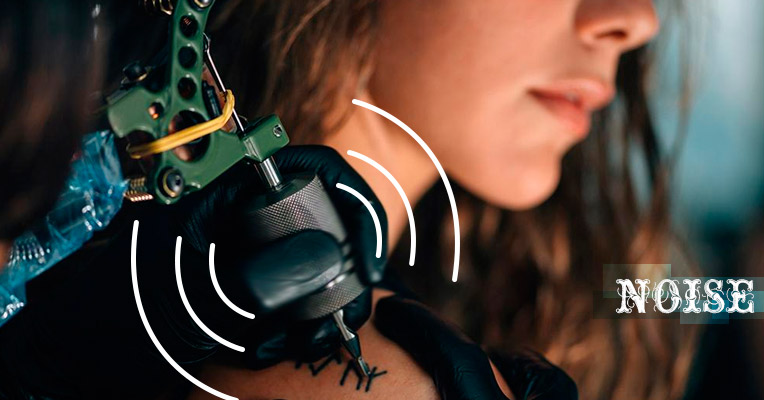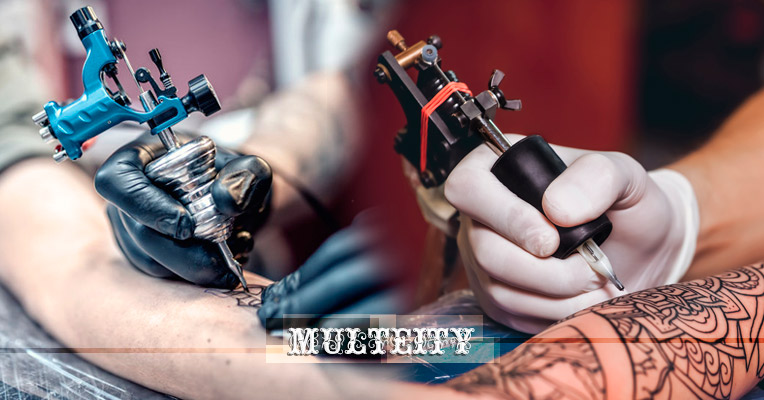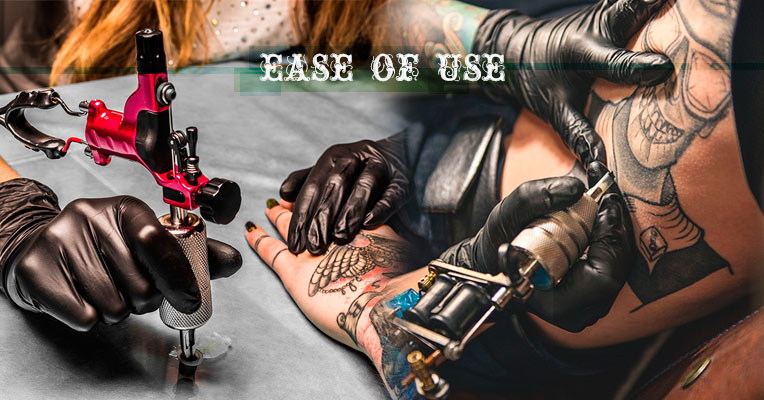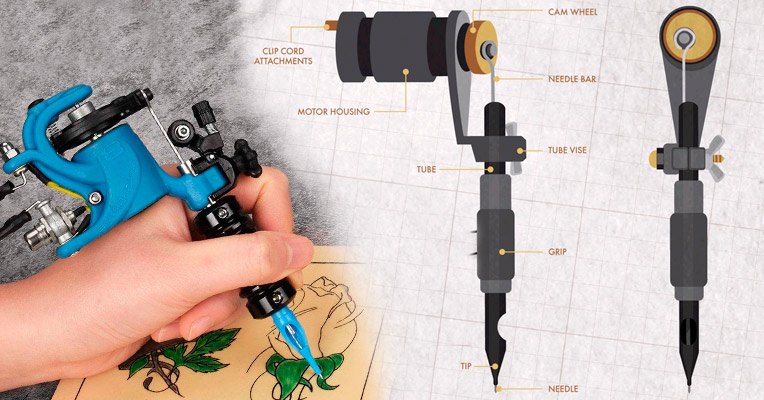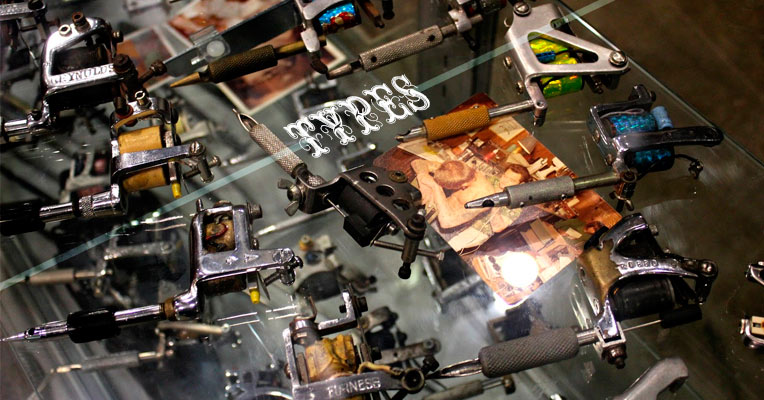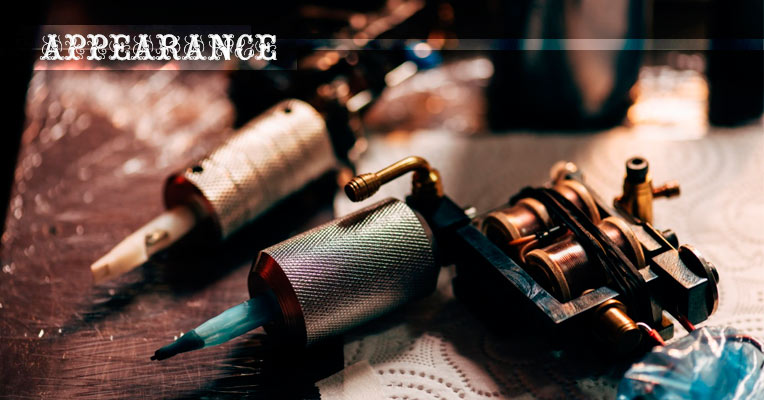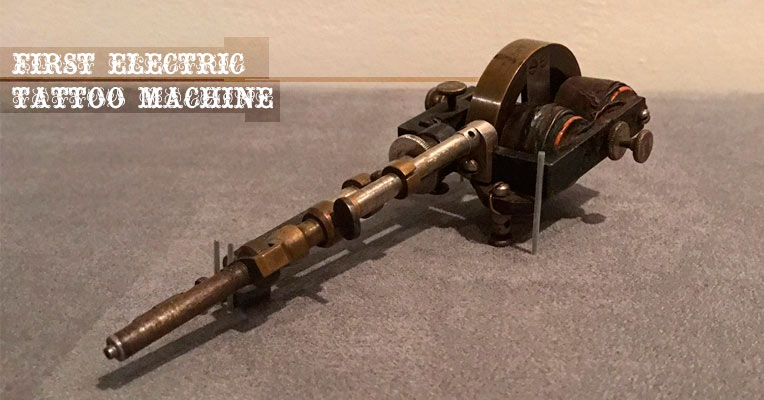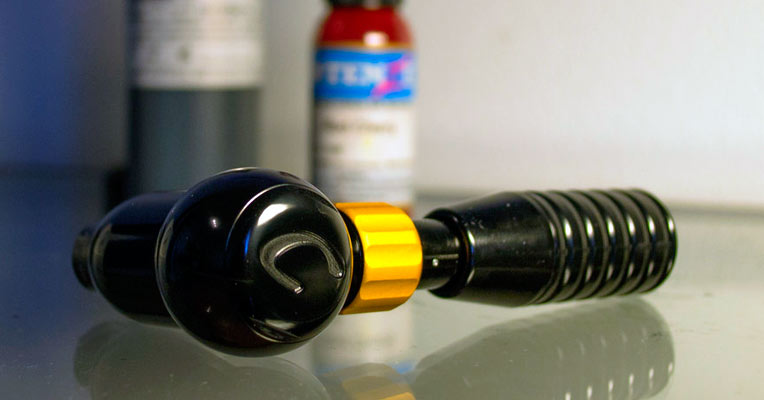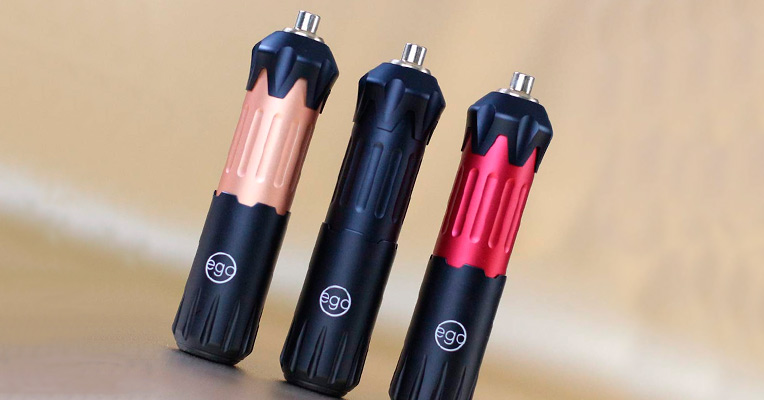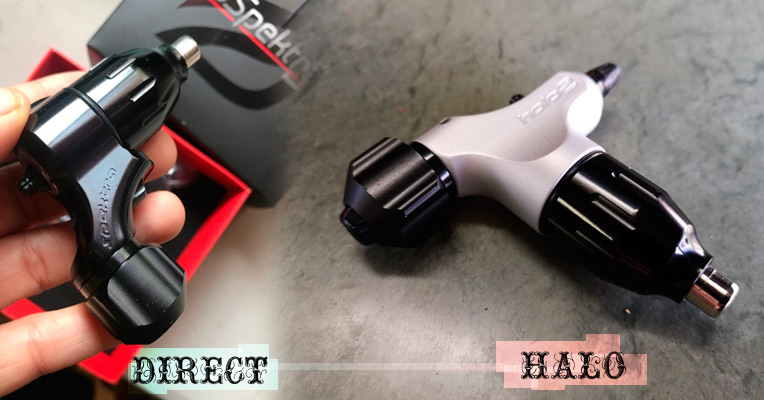First things first, the machines themselves. Rotary and coil machines operate in completely two different ways yet they help you achieve the same outcome - moving tattoo needles and driving the ink into the clients’ skin with each insertion. But the way of driving the needles is the main thing that sets them apart.
Basically, a typical coil machine is constructed with two electromagnets (coils), an armature bar (where the needle is attached to), a contact screw, and springs. And the whole mechanism works as follows:
1. When a direct electromagnetic current passes through the two coils, a magnetic field appears.
2. The created field pushes the armature bar down, breaking contact with the contact screw, thus, collapsing the circuit. In other words, the release of the springs causes the armature bar to tap the tattoo needles into the skin.
3. Then, the spring pulls the armature bar back up again, where the contact is restored and the whole process starts all over again. That is to say, this up and down motion pushes the needle in and out of the skin.
During operation, this type of machine produces a pretty loud buzzing sound you typically hear when passing a tattoo shop. Actually, this signature noise has become synonymous with tattoo art.
Rotary tattoo machines, on the contrary, are whisper quiet. They are much simpler than coil machines when it comes to design. To be more precise, they consist of a small motor, a cam wheel, a needle bar, and some additional bits. A rotary machine works like this:
1. When the power gets into the motor, it rotates the cam wheel in a circular motion (hence, the name).
2. The needle bar attached to the said cam wheel converts the rotary motion into linear. And, as a result, the needle moves in a continuous backward and forward fashion.
Owing to this straightforward design and principle of operation, rotary tattoo machines are much quieter as opposed to coils. To put it simply, there are fewer parts to deal with. Just attach the needle cartridge, plug the unit in, and here you are.
Rotary tattoo machines move needles in and out faster and more evenly than coil tattoo machines do. Yet, both types are widely used in tattoo salons. They both create amazing tattoos, even though they work using different methods. The coil machines are perhaps a bit more popular, so let’s compare their main characteristics and see why.
Noise Output Level
The noise output is the next main difference after the method of operation. As mentioned, rotary models are nearly silent if compared to the coil ones that emit a loud buzzing sound. Owing to the armature bar being released, coil machines produce a constant clicking sound that some clients may find annoying and even nervous.
Rotary style machines emit less noise, which gives clients the psychological perception that the process will be less painful.
Versatility
The rotary machine gets one more point here. They are considered to be more versatile as they can serve for both creating lines and shading. On the other hand, the coil tattoo machine can be used only for one task or the other.
To recap, a rotary tattoo unit can be used either as a liner or as a shader, allowing a tattoo artist to complete an entire tattoo painting with one machine. By contrast, coil machines can be only shaders with thick barrels and heavy coils to drive the ink easily into the skin. Or only liners with thin barrels and light coils for extra comfort during operation.
Needle Range
The needle range is fairly good in both types. A rotary machine has a very fluid needle movement, while the coil boasts a choppier movement.
Weight
Rotary tattoo machines are much lighter than dual-coil machines. This is achieved due to the design with no electromagnetic copper-wound coils to weigh down the machine. Naturally, the lighter weight means you can work longer with less hand cramping. Hence, artists that use rotary tattoo machines make fewer mistakes.
Ease of use
No wonder, rotary machines are extremely simple to use. Plus, they are less damaging to the skin; however, they don’t offer the punch and recoil that you may get with coil machines. For this reason, rotary models aren’t as effective with larger needles, so shading is a bit easier to perform with a coil machine. The coil-type units are also preferred for their ability to create super intricate lines, but they require high skills.
In sum, while coil machines require trickier maintenance than rotary units, they provide a number of benefits. And the possibility to create smooth fine lines with ease is one of them.
Although coil tattoo machines might not seem that convenient if compared to rotary models, they represent the crème de la crème of tattoo machines for many aficionados. It is all about heritage, refinement, and high accuracy of tattooing. However, that’s not the only reason to like coil tattoo machines. So, let’s plunge deeper into some other aspects of coil machines that many masters find quite interesting.
To begin with, many tattoo professionals claim that the rotary tattoo machines ought to withstand the full path lengthwise to let tattooist complete the motion, and that might be really time-consuming. In addition to that, the majority of rotary-style tattoo machines don’t respond well to the pressure of the skin, especially when compared to coil-type instruments. In its turn, this may lead to serious problems for the clients. Yet, the main advantage over the rotary machines is the fact that the coil tattoo machines make the process of scratching lines much easier than rotary machines. Also, they make them deeper.
So, we can say that coil machines have many advantages to favor them over the rotary type. The major one is that they are the best fit when it comes to refining lines, smoothing them, shading, and other intricate tasks. The other strong advantage is that coil machines have an incredibly powerful and durable motor that is crucial when you need to do needle grouping. One more perk is the ability to give professional tattoo artists more control over the process. Finally, we would like to emphasize that the coil tattoo machines are much easier to customize or build on your own.
It shouldn't come as a surprise that coil tattoo machines may trail behind the competition in some aspects when it comes to rotary-type tattoo machines. So, let’s check the key benefits of using rotary tattoo machines over the coil-style units.
Less Weight
Compared to coil tattoo machines, rotary machines are much lighter and, accordingly, more suitable for prolonged use. This is largely achieved due to the fact that they are constructed with fewer parts to assemble. To put it differently, since the rotary guns don’t contain coils at all, they are lighter on the hands. And it's easier to use and set up tattoo gun of this type.
Virtually Silent
The coil tattoo units are overly loud with their buzzing noise. For this reason, many masters (especially beginners) find them annoying to work with on a daily basis. Alternatively, rotary tattoo devices of the present day are virtually silent. An interesting fact - since they are so quiet, it’s the top choice of prisoners. They can tattoo their friends without fear of getting caught and their gear confiscated.
Multipurpose
It goes without saying that every artist is different, but modern rotary tattoo machines offer great versatility to each of them. That’s because of the fact they can be used either as a liner or as a shader. A perfect 2-in-1 machine.
Cost-Efficient
As mentioned, one neat rotary machine can substitute two separate devices. In addition to that, it’s made of fewer elements and is cheaper than coil machines in most cases. And not only they require less money to manufacture. They also cost less to acquire and maintain.
Less Vibration
The final point to note here is less vibration. This aspect is especially crucial for novice artists that require a steady hand and maximum precision to ink their clients. And whereas a coil machine can vibrate too much (thus, comprising the precision), that will never happen to the rotary-styled tattoo machine. It provides far less vibration and keeps your hand steady, allowing you to create fantastic artwork.
To sum up, coil tattoo machines usually require a lot of experience, which makes them an inaccessible option for entry-level tattoo artists. They also have more parts and require more maintenance when compared to rotary tattoo machines.
Rotary and coil units are completely two different types of machines. And there is no right answer what are the best tattoo machines for you. It’s all about your personal style of tattooing, preferable brands, and models.
When it comes to painful sensations, it’s quite hard to judge. All tattoos hurt. But the main advantage of rotary tattoo machines is that they do not make any noise when in use. That means they don’t increase anxiety levels and your clients will have the perception that the tattoo process will be less painful. This is a big bonus for the artists that are just starting their career, as well as for the clients who are new to tattooing.
The aggressive buzz noise of coil machines tends to make individuals scared of the fact that the tattooing process would be extremely painful. In reality, it’s just a mental thing but it tends to drive the first-time clients away that believe it’ll be extremely painful to get their tattoo done.
Our guess is that it’s the style of tattoo and its location that are the main factors of the increased volume of pain.
Besides coil and rotary tattoo machines, you can also find other types. Machines are usually subdivided into long-stroke and short-stroke models. As a rule, long-stroked machines are best for coloring, shading, and sculpting lines. They do less damage to clients' skin.
Short-stroke machines are typically used for lining in a single pass. They can help you achieve subtle gradations of black (just like those found in portraits). Also, the machines vary in length, width, tension, angle of deflection, stiffness of the springs, and contact gaps.
- Liner tattoo machines are typically short-stroke devices that allow artists to make solid lines in a single pass. The main purpose of this type of machine is to create a dominant line and lay the ink in one single pass. The liner uses a short contact circuit that makes it to cycle faster.
- Some shader tattoo machines are also capable of creating short strokes. However, most of them are long-stroke machines that do much less damage to the skin. They are great for coloring, shading and sculpting lines. It’s worth emphasizing that shader tattoo machines are commonly used to shade black ink and its variations. The saturation level of this type of machine is rather low since it uses a larger contact gap than a liner machine. Some tattoo artists use shader machines for all lines.
- Pneumatic tattoo machines were invented quite recently, in 2000. These machines are powered by an air compressor and use pressurized air to drive the needles up and down. These machines are extremely lightweight and compact - the assembled machine can fit in an autoclave. For this reason, they are also easily sterilized.
Actually, tattoo machines have quite a long history. And when speaking about the creator, the name of Thomas Alva Edison comes to mind. This legendary man developed the first prototype of the tattoo machine - the electric pen (also called Stencil-Pen), in 1876. It was intended to be used just as a duplicating device used by businesses. It had a high-speed reciprocating motor that drove a single needle that created perforated holes. It didn’t use any ink.
However, fifteen years later, in 1891, the electric pen was significantly modified by Samuel O'Reilly, a professional tattoo artist. He discovered that Edison's machine could be upgraded and used to drive the ink into the skin. He added a tube, multiple needles, and an ink reservoir. That’s how the first tattoo machine appeared. This revolutionary device was the main breakthrough in the tattoo industry that opened the door to a whole new generation. By the way, the rotary operated stencil pen was technically a rotary-electromagnetic coil hybrid.
Some people say that twenty days after Samuel O’Reilly obtained his patent on the rotary machine in the U.S., the Englishmen Tom Riley created a single-coil machine. He created it with a modified doorbell system placed in a brass box. However, he didn’t patent his invention.
The modern two-coil machine based on a doorbell mechanism was patented by Alfred South in England, on March 24, 1900. Yet, it was so heavy that spring was attached to the top of the machine and the ceiling to reduce the load on the artist's hand.
In 1929, Percy Waters patented a new machine that resembled the modern-day models. His machine also included two electromagnetic coils but they were set parallel with the frame. This machine was much lighter and more maneuverable.
Rotary and coil machines aside, the new type was invented by tattoo master, Carson Hill, in 2000. More than 100 years after the inventory of rotary and coil tattoo machines, a brand new pneumatic tattoo machine has appeared. It was powered by air compressors driving needles up and down. It’s extremely lightweight and completely autoclavable. But even despite these significant advantages, pneumatic tattoo machines are not that popular compared to rotary and coil devices among tattooists today.
Over the years, tattoo has become a very precise form of art. And the advances in precision have led to a new subdivision - facial tattooing, also called derma pigmentation or permanent cosmetics. In addition to enhancing the color of your brows and lips, it allows for removing freckles, beauty spots, and scars.
No matter whether you want to go for an old school coil tattoo machine with traditional buzzing or gravitate towards new school rotary tattoo machines with a quiet motor, you should decide what brand to stick to. There are thousands of options to choose from, and here we look at some top-rated brands to help you with the selection process.
Cheyenne tattoo machines
At the moment, the Cheyenne Hawk tattoo machine is one of the most modern and technological models for tattoos out there. This machine is super-fast and accurate, and all its consumables are completely disposable. That is to say, it works faster than any other machine and provides faster healing after the procedure. Also, it brings a quite soft effect on the client’s skin.
It was carefully designed and tested to meet very demanding specifications. So, no wonder it allows artists to work with exceptional control and response. It’ll adjust to your every movement to let you excel at your craft.
Speaking about the type, it belongs to a rotary type, meaning it doesn't sacrifice the feedback response found in coil machines. It weighs just 25 pounds when fully assembled and can be used with any conventional power supply or a control unit PU II if desired.
Another high-quality model from the Cheyenne brand is the Spirit. It’s also very lightweight, flexible, and made with a long-life ball-bearing motor. It works amazingly well with any skin type. Its cartridges can be changed quickly and the needle depth can be customized easily.
Shuba-K Custom Tattoo Machines
Proudly manufactured in France, Shuba-K Custom machines are great for those individuals that look for traditional "old-school" models. The machines give a high-quality pixel effect and are great for dense colors.
Bishop Rotary Tattoo Machines
The Bishop Rotary tattoo machine boasts perfect balance, durable materials, and a long-life motor. At 4 oz, it feels almost weightless, thus, it’s a stellar option for prolonged use and large tattoos. It eliminates wrist pain and can even alleviate carpal tunnel symptoms. The machine is encased in billet aircraft-grade aluminum that is further hand-polished and anodized to aircraft industry standards.
It’s worth emphasizing that the Bishop Rotary machines are built with a needle clip rather than a standard rubber band. The machines are hand-assembled with a fine Swiss motor that carries a lifetime warranty. So, if you look for a machine that will stand the test of time, Bishop has quite a lot to offer.
Dragonfly Tattoo Machines by Ink Machines
Ink Machines is a Swedish manufacturer that works closely with professional tattoo artists to deliver you the best machines in the tattoo realm. The company uses broad industry knowledge to develop unique rotary tattoo machines at competitive prices. The mission is to make tattooing easier and more affordable.
The Dragonfly rotary tattoo machine is an ergonomic device made from the finest quality materials. It’s perfect for fitting and high-speed painting of large areas. Dragonfly is one of the top choices for those who look for professional tattoo machines.
Ego Tattoo Machines
The Ego tattoo machine is created by the world-famous tattoo artist Bez of Triplesix Studios (England). It has a very wrist-friendly design with an almost pen-like feel that allows for maximum control. The machine is made from robust, scratch-free plastics and has a UV coating.
Though, the newer Ego Apex Overkill machine from the brand is manufactured from aircraft aluminum that adds some weight to the whole unit.
Both machines come with a variety of Bez's unique "power triangles" in different colors, i.e., different rubber densities. They allow tattooists to alter the give of the tattoo machine to their preference. In general, the Ego tattoo machines are suitable for lining, shading, coloring, and blending.
Skin 2 Rotary Tattoo Machines
As it goes from its name, the Skin 2 rotary machine is a rotary-type device. It also has an adjustable give, allowing you to control needle-hitting density. This allows tattooists to tailor the machine to lining, coloring, filling, or shading. Importantly, the machine goes from scratch to 155 stitches per second in an instant.
Besides the adjustable needle intensity, the machine has some other benefits. It's made with a reliable Swiss motor that works nearly silently and produces minimal vibrations. When using this machine, artists don’t need rubber bands to tighten the needle bar - it’s fitted with a classic clip cord connection and RCA. Overall, the Skin 2 rotary machine is an all-around option suitable for both novice artists and professionals.
InkJecta Tattoo Machines
InkJecta tattoo machines are one of the most popular models in history. Its Flite v2.1 model is the only machine of its kind on the market. It’s famous for its ability to run at very low speeds without affecting the power or doing damage to the skin. Hence, it helps artists create superior-quality tattoos.
The Flite v2.1 comes with a 3.0mm, 3.5mm, and 4.0mm interchangeable cam systems as well as a hard, medium and soft interchangeable flex system. The InkJecta Flite v2.1 tattoo machine has a lightweight fiber construction and is treated with the INOX food-grade lubrication.
Spektra Rotary Tattoo Machines
Spektra Rotary Tattoo Machines are produced by Fallen King Irons, the company started by a couple of tattoo artists making simple machines for friends that now grew into an iconic tattoo company. Its Spektra model is available either in the Halo or Direkt rotary designs.
The Spektra Halo has a wide range of advanced features including an autoclavable body and innovative MotorBolt System. The interchangeable MotorBolts give you the flexibility of switching between different strokes on the fly. Also, the MotorBolt is a good back-up source in case of failure.
As for the Spektra Direkt, it’s the first machine of its kind. It’s featured with body-mounted strokes that stay inside the body, meaning it’s an ideal dedicated-task machine. The Spektra Direkt is produced from 7075 Aircraft Grade Aluminum, anodized in 7 colors and hand-polished to a mirror-like shine. It comes with an adjustable stroke system that offers 3 different options. It’s a maintenance-free machine with a Hex Drive motor system.
As you see, the choice is really vast. And we hope that our article has helped you on your way to mastering the art of tattooing.

